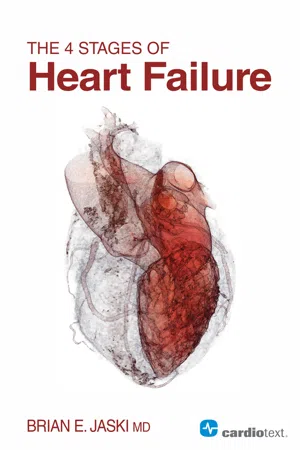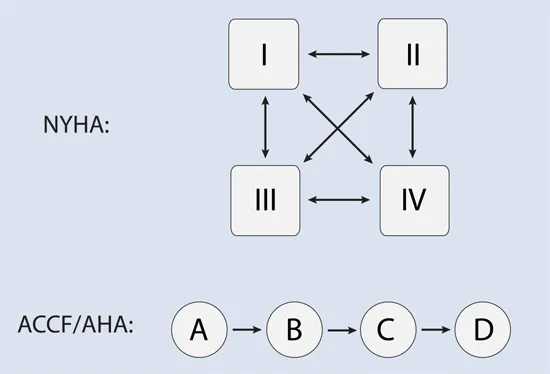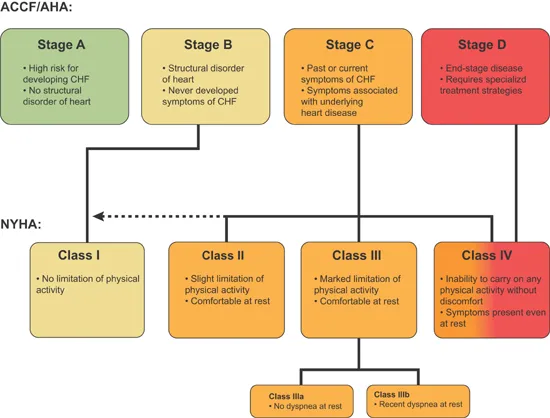
- 336 pages
- English
- ePUB (mobile friendly)
- Available on iOS & Android
The 4 Stages of Heart Failure
About This Book
This book applies practical clinical concepts to the latest four-stage model of heart failure from preclinical risk and early asymptomatic disease to classic symptomatic heart failure and finally advanced heart failure. This framework emphasizes a tailored approach to ongoing heart failure assessment to guide therapy and improve outcomes.Features: • Illustrated with over 250 full-color figures• Specific recommendations backed by clinical trial data• Practical algorithms for diagnosis and therapyTopics include: • Prevention of heart failure• Identification and treatment of structural heart disease prior to heart failure• How to combine lifestyle changes, medications, and devices to improve outcomes• Reversing decompensated heart failure• Key indicators of advanced heart failure and appropriate treatment options• Emerging new therapies
Frequently asked questions
Information
CHAPTER 1
Heart Failure Diagnosis and Epidemiology
Heart Failure Recognition
CLINICAL CRITERIA OF HEART FAILURE
MAJOR CRITERIA | MINOR CRITERIA |
Acute pulmonary edema | Dyspnea on exertion |
Paroxysmal nocturnal dyspnea or orthopnea | Night cough |
Neck-vein distention | Tachycardia (> 120 beats/min) |
Rales | Pleural effusion |
S3 gallop | Hepatomegaly |
Abdominojugular reflux | Ankle edema |
Cardiomegaly on chest x-ray | Vital capacity decrease (1/3 from max) |
Increased venous pressure (> 16 cm H2O) | Weight loss* |
Weight loss* |
HEART FAILURE CLASSIFICATION


Epidemiology
Table of contents
- Cover Page
- Title Page
- Copyright Page
- Table of Contents
- In Gratitude
- About the Author
- Foreword
- Preface
- Abbreviations
- Introduction
- Chapter 1 HEART FAILURE DIAGNOSIS AND EPIDEMIOLOGY
- Chapter 2 HEART FAILURE PRESENTATIONS AND FUNCTIONAL TYPES
- Chapter 3 STAGE A: PATIENTS AT RISK FOR DEVELOPING STRUCTURAL HEART DISEASE
- Chapter 4 STRUCTURAL HEART DISEASE AND PROGRESSION TO FAILURE: STAGES B, C, AND D
- Chapter 5 STAGE B: ASYMPTOMATIC STRUCTURAL HEART DISEASE
- Chapter 6 ASSESSMENT OF STAGE C PATIENTS WITH HF- r EF
- Chapter 7 ASSESSMENT OF STAGE C PATIENTS WITH HF- p EF
- Chapter 8 STAGE C: IMPROVING OUTCOMES IN SYMPTOMATIC HEART FAILURE
- Chapter 9 STAGE C: THERAPIES FOR ACUTE DECOMPENSATED HEART FAILURE
- Chapter 10 STAGE C: CARDIORENAL SYNDROME
- Chapter 11 STAGE D HEART FAILURE: OPTIONS AND OPPORTUNITIES
- Chapter 12 A PATIENT-ORIENTED PERSPECTIVE TO THE 4 STAGES OF HEART FAILURE
- Appendix A: Glossary
- Appendix B: Summary of Clinical Trials of Therapy
- Index